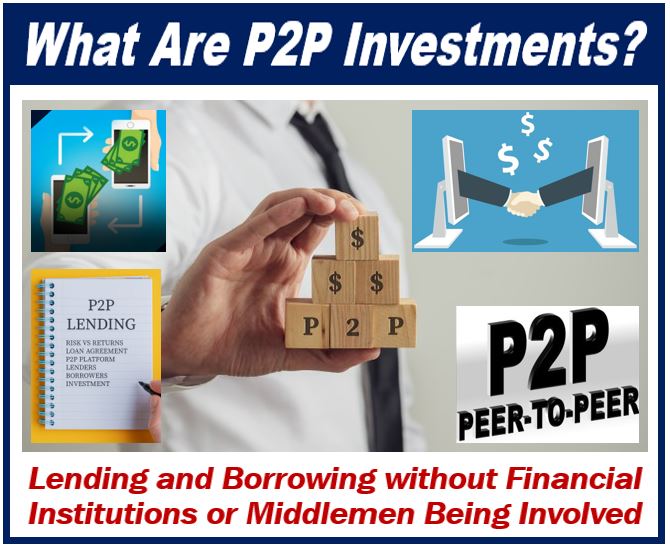Peer-to-peer investments or P2P investimas is the recent favourite among the yield-seeking investors as the stock market and bond rates continue to be disappointing. For the past ten years, P2P investment became an alternative investment solution for those seeking to achieve some solid returns.
P2P is non-banking banking that allows you to lend money to the borrowers by cutting out the middleman—the bank. Instead of investing your money through a bank, you invest directly in the loans taken by the borrowers on P2P platforms.

This relatively new market thrives day by day and is estimated to reach $150 billion by 2025.
But P2P lending is a risky investment; hence, you must know how the platforms work and the overall pros and cons of P2P investments before investing.
According to Arminas Orantas, a Lithuanian financial analyst: “Kaip rodo mūsų analizės duomenys, P2P investavimas daugumoje šių investavimo platformų atneša 8-12% metinę grąžą.” (According to our data, most of these P2P investing platforms bring annual investment returns of 8-12% )
How the P2P platforms usually work?
P2P platforms can be described as social platforms where people seeking a better investment opportunity can lend funds, and the people who need to borrow can borrow from the people lending. And, the role of those platforms is to create purchasable loans. Investors buy the loans and, in return, get money as interest, including the invested capital. The money they are investing is given to the person who requires the loan. Higher interest rates result in the system being scrutinized.
Unlike a bank, the most commendable feature of P2P lending is its simplicity and transparency. With the hierarchy and a pile of paperwork, banks often come with hidden or perplexing fees. On the other hand, most of the P2P platforms have a page dedicated to the fees they charge. More, they explain how they make money in simple terms. Remember, each platform charges fees differently. So, it’s wise to compare the features each platform offers before investing.
The major P2P players in Europe
Currently, the most popular and best-rated platforms in Europe are—Reinvest24, Crowdestor, Profitus, EstateGuru, Mintos, Debitum Network, PeerBerry, Moncera, NEO Finance, and Bondora. According to our data, most of these P2P investing platforms bring annual investment returns of 8-12%. For instance, Crowdestor claims to generate an average yearly ROI of 12%.
But, you must keep in mind, the higher the interest rate, the higher the risk. Hence, take a good look at a project before investing in it.
How do you invest in P2P lending?
You can start investing in P2P lending by following these simple steps. You’ll have to:
- Choose a P2P lending platform
- Open an account
- Deposit funds
- Begin reviewing potential borrowers.
Each platform outlines the qualifications, procedures to begin, and required minimum investments.
You can choose the borrowers you want to lend the money, after reviewing their profiles. The borrower profile includes the information:
- Interest rate
- Reason for the loan
- Term of the loan
- Risk assessment
You can decide if you want to fund all your money to one project or just some of it. The wise move is to invest small amounts into multiple loans instead of investing a large amount in one. Thus you can decrease the risk by diversifying your investment into different grades of loans with different terms of maturity.
Advantages of P2P investment
- You can support small business or individuals by lending fund
- You can start investing with a small amount of money
- You can customize loans—the amount of loan, risk level, terms, and so on.
- Diversify your loan portfolio by investing in multiple loans
- Achieve higher yield than the currently available source (savings account, Stock market, etc.)
Disadvantages of P2P investment
- P2P investment comes with a high risk of losing money, specifically, the capital if borrowers default on loans
- Invested capital is bound to the full term of the loan
- P2P lending is a relatively new investment method and not long-term tested in marketplaces.
- Qualifications and restrictions vary from platform to platform.
Is it an effective way of making money?
Though P2P lending is relatively new in the investment field, it comes with a plethora of opportunities for individuals to jump into the lending process, even with a small amount of funds. More, it’s up to you whether you want to invest your entire fund in one project or invest a small portion of it.
You can redeem the risk by investing small amounts in multiple loans instead of investing a large amount on one. Once the loan is fully funded (multiple investors with a small portion of funds may involve), the borrower begins to make the payment. With each payment of the loan, a portion that includes capital and interest returns to each investor.
P2P investment can provide you with a healthy return with the right platform and reliable income source. Like other investments, it also involves risks and rewards; hence, it needs careful consideration of all the terms and conditions.
Interesting related article: “What is an Investment?“

